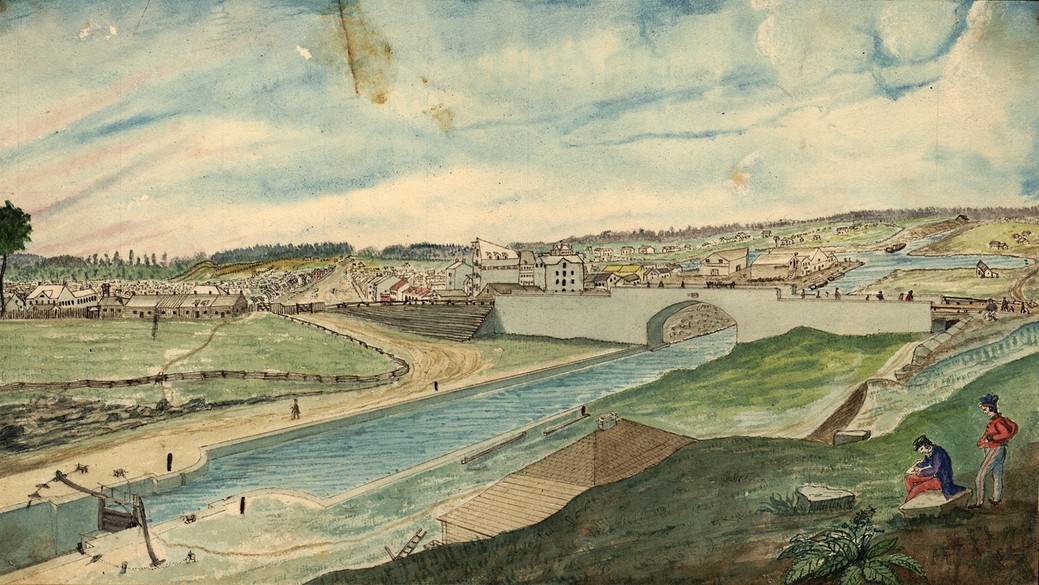
The Early Days of Ottawa: Not a Handsome City
Painting showing the Sapper's Bridge and Lowertown around 1845. The big street going off to the left is Rideau Street. Painted by Thomas Burrowes, he added himself into the scene, painting away on what would be Parliament Hill today – Archives on Ontario C-1-0-0-0-11

Ottawa has undergone an incredible transformation since Colonel By first arrived in 1826 and founded Bytown. Starting as an encampment for labourers, it was quickly laid out as a village, and gradually developed into a town, a city, and finally the Capital of a newly formed country.
Ottawa has arguably changed from its roots moreso than any other city in Canada. Unlike it's counterpart in Washington DC, present-day Ottawa would be almost unrecognizable to its founding fathers.
Apparently, by 1884 it still hadn't transformed into a very attractive place. As Prime Minister Wilfrid Laurier put it:
"I would not wish to say anything disparaging about the capital, but it is hard to say anything good. Ottawa is not a handsome city, and does not appear destined to become one either."

Ottawa was a rough place, without a doubt, but was well on its way to becoming the elegant city we know today.
Here are some of the highlights from Ottawa's formative years:
The Rideau Canal and founding of Bytown
The story of the building of the Canal is highlighted by three names in particular: Lt-Cl. John By, Thomas McKay, and the Governor-General, George Ramsay Earl of Dalhousie. John By was a Royal Engineer, who had previously served in British North America, working on the fortifications in and around Quebec City between 1802-1811. He was known for being very disciplined, but also for being good-natured and likable.
On his way to the site of the Canal, By stopped in Montreal and met Thomas McKay, a stonemason who had been working on the Lachine Canal. By decided to bring him along, and on September 21st, 1826, they arrived in Wrightstown, greeted by Philemon Wright himself.
McKay would go on to win the contracts for the building of the canal entrance locks, parts of the Union bridge, and later the county jail and courthouse, which still stand on Nicholas St. today. He also built Rideau Hall, the first sawmills on the Rideau falls, and he founded the neighbourhood of New Edinburgh. Work didn't start straight away on the canal. There were still preparations to be made, and work wouldn't actually begin until the next spring. In the meantime, the Governor General, the Earl of Dalhousie, came for a ceremonial turning of the sod. The Earl had big plans for the canal…
Lord Dalhousie, as he was known, had already purchased a 600 acre parcel of land for the government, which stretched from the Rideau Falls to present-day Parliament Hill. He was convinced that the canal project would lead to a permanent community.

Before leaving, Lord Dalhousie gave Colonel By recommendations for clearing and surveying this parcel of land, and laying it out in two or four acre plots. By followed his recommendations and laid out plans for two communities; one on either side of the canal.
Lowertown was to the east, and Uppertown to the west. Each one had a main thoroughfare running through it: Rideau St. and Wellington St. respectively. This was the start of the new village of Bytown.
In 1827, the Sappers Bridge was built over the canal, connecting the two communities and creating one unified village. When the bridge was demolished in 1912, to make room for Union Station, dynamite barely made a mark in the stone arches. They had to resort to dropping a 4,000 pound boulder from a height of 55 feet, over and over for three straight hours, before the bridge came down.
At first, the name Bytown was actually a bit of a joke. The community had no official name, but Colonel By was such an imposing figure that people named it after him in jest; a play on the name of Wrightstown across the river. However, the name was so appropriate that it quickly caught on in common usage. It became official in 1829, when the post office moved in and all the post was marked 'Bytown'.
Early Demographics and the Shiner's War:
The population of early Bytown was divided between four main ethnicities: English, Scottish, Irish and French.
The French and Irish made up most of the labour for the canal project. They were the lower-classes, and mostly lived in Lowertown. They were also mostly Roman Catholic. The English and Scottish made up the upper-classes and lived in Uppertown. They were mostly Protestant, and dominated the governing of the new community. With this stark divide between Uppertown and Lowertown, it seems almost inevitable that some kind of class struggle would have developed between the two groups. Instead, a struggle developed between the Irish and French in Lowertown, while the gentry of Uppertown were left to watch. It became known as the Shiner's War.

It all started as the canal project was coming to an end in the early 1830s. The French and Irish labourers were out of work and looking for new jobs. The French were generally able to get jobs in the lumber camps that dotted the Ottawa valley. They did, after all, have a reputation as the best and most experienced woodsmen in North America. Most French families had already been living in Canada for generations.
The Irish weren't so lucky. They were mostly new immigrants, with no experience as woodsmen, and were left to fend for themselves. One way to do so was to form gangs and try to push the French lumber workers out of town, freeing up jobs for the Irish.
One gang became known as Shiners, and by 1834 they were all united under the leadership of lumber baron Peter Aylen. Aylen had originally moved to the area to work for Philemon Wright in 1815, and by 1816 was running his own logging operation. Originally from Ireland, he was one of the earliest permanent residents of Ottawa.
Meanwhile, the French had their own champion: Joseph Montferrand. Today, Ottawans might be more familiar with the name Big Joe Mufferaw, the mascot of the Ottawa Redblacks and Canadian folk hero. But, once upon a time, Big Joe was a real person, living right here in Ottawa.
Montferrand was known for his incredible strength, and for being a champion boxer. By 1829 he was working as a rafting foreman for the Gilmour logging company, giving him plenty of experience dealing with the Shiners.
One story tells of 150 Shiners ambushing Big Joe on the Union Bridge. Legend has it that Montferrand grabbed the nearest man, took him by the ankles, and swung him like a club, knocking the others to the ground. He threw all 150 men off the bridge and into the river. The stories of Big Joe may or may not be known for their flagrant exaggeration.

The Shiners 'War' was mostly a series of violent incidents between these two groups. It often involved timber rafts being seized and destroyed, and the crews being beaten. They even murdered one man by throwing him off the Union Bridge, into the Big Kettle. Other times, they preferred to burn down their rival's homes.
The magistrates of Uppertown mostly ignored the violence, until it started to affect them. In 1837, Peter Aylen led his Shiners on a township meeting and essentially tried to take over the town by forcing the magistrates to elect all Shiner members to town council. The meeting ended in a riot. This was the beginning of the end for the Shiners, and by 1838 Peter Aylen had fled Ottawa, and with him, the influence of his Irish gang.
The full history of the Shiner's War is well worth looking into for anyone interested in Ottawa's history. It reads like a real-life version of the movie Gangs of New York.
The Lumber Industry
Ottawa's early history is dominated by the lumber industry. It's no secret that Ottawa was once widely known as a rough and tumble lumber town, and after the canal was completed almost everyone in town had some connection to the industry.

The lumber industry in the Ottawa valley was initiated by two men. The first is not surprising: Philemon Wright, who seemed to be at the forefront of almost every major initiative in Ottawa's early history. He floated the very first timber raft down the Ottawa river, to Quebec City, in 1806.
The second man was a little less obvious, although you've probably heard of him: Napoleon Bonaparte. In 1806, the Napoleonic Wars were raging in Europe and the emperor issued the Berlin Decree, which shut Britain out of the Baltic lumber markets. Britain was forced to turn to its North American colonies for valuable, ship-building timbers, and the lumber boom began.

Over the next 40 years, rafts of square timbers became a common sight on the Ottawa river, making their way to the St. Laurence, and eventually Quebec City. However, by the 1840s, the Baltic lumber market had been re-opened to Britain, and the square timber industry in the Ottawa valley experienced a big decline.
The logging industry was saved in 1854 with the Reciprocity Treaty between Great Britain and the United States. This treaty allowed British North America to export sawn lumber to the U.S. free of duty.

All of a sudden, the square timber rafts that had dominated the scene took a back seat to sawmills. Between 1849-1853, a group of American entrepreneurs moved to Ottawa and built sawmills on the Chaudière and Rideau falls.
However, from 1854 forward the industry was clearly dominated by sawn lumber, and eventually pulp and paper as well.In 1855, the year after the treaty with the U.S., Ottawa mills produced over 39 million board feet of sawn lumber. The industry boomed for the next 50 years. At the height of the boom, the Ottawa area might have been the largest lumber complex on the planet.

Above: The Edwards Mills on the Rideau Falls, previously built and owned by Thomas McKay. Below: a group of mills on the Chaudière falls. This one is most likely either the Perley or Bronson mill. – Bond and Hughson,"Hurling Down the Pine", p.36; McCord Museum MP-0000.25.879


Most of the names of Ottawa's lumber barons are still familiar in the city today, lending their names to many of the streets that make up the downtown core: Bronson, Gilmour, Maclaren, Booth, and Eddy to name a few.
Becoming Ottawa
The year 1854 saw the arrival of the first train in Bytown, on Christmas day. The Bytown and Prescott Railway and the St. Lawrence and Ottawa Railways connected the town to the rest of Canada. Bytown was no longer such an isolated place.
That year, Bytown's population had reached an estimated 10,000 citizens, giving it a big enough population to apply for city status.
Henry J. Friel – the seventh and last mayor of Bytown – made a formal request to the government of the Province of Canada, and on January 1st, 1855, Bytown was officially incorporated as a city. But it wasn't Bytown anymore.

The town council, along with the Provincial government, agreed that the new city would need a more appropriate name. It had long been suggested that the town be given an aboriginal name. The name Ottawa, actually had a greater historical meaning than most people think.
Two-hundred years previously, a truce between the Iroquois and the French had re-opened trade on the Ottawa river, after a period of excessive violence between the two groups. During that period, no one dared travel on the River. After the truce, it was the Odawa people who began travelling and trading on the River again, and the naming of Ottawa was meant to commemorate the 200th anniversary of this.
Becoming the Capital
No single event transformed and shaped Ottawa more than its naming as the Capital of the Dominion of Canada in 1858.
In 1840, the Union Act had united Upper and Lower Canada into the singular Province of Canada, and Kingston was chosen as the Capital. Right away there was a lot of tension between Canada West and Canada East, and where the seat of government should be.
Charles Lord Sydenham, the first Governor General of the Province of Canada, was also the first to suggest Ottawa (still Bytown at the time) as the potential Capital. His successor, Sir Charles Metcalfe, visited the town to see it's potential. He thought that it was in the perfect geographical location, but was too small to be the Capital.
By 1855, Bytown had grown into the city of Ottawa. The Capital of the Province had also moved four times by that point; going from Kingston, to Montreal, to Toronto, to Quebec City.

The legislators of the Province couldn't agree on where the Capital should be, so they asked Queen Victoria to settle the matter and choose a permanent location.
It's a matter of debate as to how much say the Queen actually had in the decision. Some historians argue that the legislators of Canada had already chosen Ottawa and simply asked Queen Victoria to make the official announcement so that the other cities couldn't question the decision.
Others argue that there was a real debate within England as to the location of the Capital. Competing cities actually sent delegations to London to argue on their behalf. Meanwhile, the current Governor General, Sir Edmund Head, visited Ottawa and recommended the newly named city to the Queen.
On December 31st, 1857, the government of Canada was informed that the Queen had chosen Ottawa. Two years later, in late 1859, ground was broken for the building of the Parliament buildings.

By the 1880s, the changes in the city were starting to become more visible.
Ottawa was still a major lumber town, with a large working class dominated by the French and Irish. The city was dominated by industrial buildings: mills, factories, warehouses, taverns and stables. It's no surprise that Sir Wilfrid Laurier didn't think of Ottawa as a very handsome place.
But, there was a growing privileged class in Ottawa, living in Uppertown and Sandy Hill, and working as government officials, merchants, physicians, lawyers and mill owners.

The industrial core of the city was increasingly being built over with new, elegant buildings, more befitting of the national capital. The first of these were the Parliament buildings, which replaced the old military and civilian barracks.
Notre Dame Cathedral was started in 1841 and by 1858 it had taken its present form, and brought some architectural magnificence to Lowertown. In 1877, a new City Hall was constructed on Elgin St., and in 1883 the Post Office was opened at the site of present-day Confederation Square. In 1880, the Russell Hotel, also on the site of Confederation Square, was rebuilt and became the most prestigious hotel in Ottawa until the Chateau Laurier was constructed.

Above: The Russell Hotel (ca.1883) gave Ottawa a high-class establishment right right in the center of town. ( Library and Archives Canada PA-008434) Below: The Post Office, sitting between the two bridges, was built in the Second Empire style, and was demolished (along with the Russel Hotel) in 1938. ( Library and Archives Canada PA-008344)

By 1883, the Ottawa City Passenger Railway was well established, and could bring passengers from Chaudiere falls to New Edinburgh.
Ottawa College (now University), was also well established and taught philosophy, theology, zoology, languages and mathematics.
A picture of Ottawa in 1908 shows a city that would be more recognizable to us than it would be to the likes of Colonel By or Lord Dalhousie. By the turn of the century, Ottawa's formative years were coming to an end, and the city was finally coming into its own as the Capital of Canada.

Ottawa in 1908 – Archives of Ontario I0026563
You can find more writing by Philip Charlebois on his blog, “Ottawa Hockey History.” Also, check it out on Facebook!









